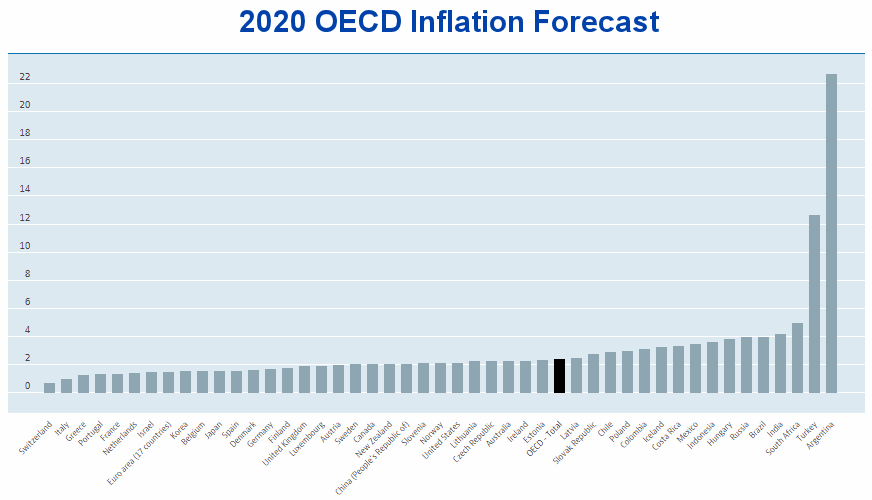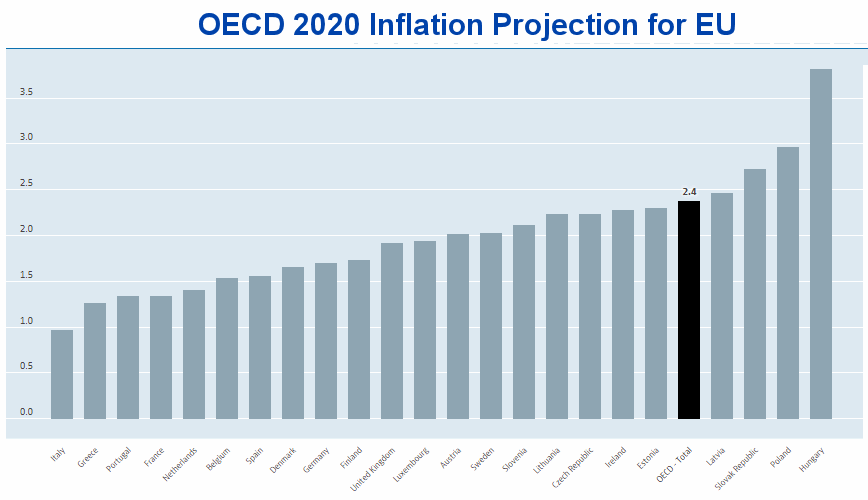While inflation has been low in most developed countries over the last decade, there are places where it is starting to pick back up, with stronger growth outlooks for several major economies. As we can see from the chart below the OECD is projecting massive inflation in 2020 for both Turkey and Argentina at 12.6% and 22.7% respectively. The average of all OECD countries is a low 2.4%.
The OECD Inflation projection for the European Union (EU) is also surprisingly low. Who would have thought that countries like Italy, Spain and Portugal could maintain such low inflation rates, with the highest being Hungary at 3.8%. Back in June 2019, the Telegraph published an article about how the EU was still fearing deflation. During deflationary periods where your money gains purchasing power, simply earning one or two percent and getting your original investment back is a good strategy. But if your dollars are rapidly losing purchasing power you have to do something else or your money will soon be worthless.
Source: OECD Inflation
What Is Inflation And How Does It Impact Your Money Over Time?
The Bureau of Labor Statistics defines inflation as “the overall general upward price movement of goods and services in an economy”. So, when inflation occurs, your buying power is negatively impacted i.e. it takes more money to buy the same amount of goods and services than it did in the past. Therefore, the higher the rate of inflation is, the more it decreases the value of your money over time.
How Investing Can Help You Maintain Purchasing Power
As inflation shrinks the value of your savings, you need to find ways to counter this. Once you have enough savings to consider investing, you should make efforts to do so, as this can help you maintain (if not improve) your overall purchasing power. Therefore, taking a little bit of risk through investing can help you avoid losing money over time, but you also need to find the right savings and investment products for you.
Putting your money in classic savings accounts are low-risk options with easy access to your money. But you could also consider tax-advantaged accounts. These accounts, such as a 401k in the United States or a TFSA in Canada, can be great ways for you to save money and invest it for the future, while also taking advantage of protection from taxes. As we can see from the charts above how poorly your savings fare depends a lot on where you live and what currency your savings are denominated in. By eliminating the tax bite you can improve your overall rate of return and have a better chance of beating inflation.
What’s the Best Way to Mitigate and Control Your Risk While Investing?
If someone were to offer you 49% interest on your savings, you might initially jump at the opportunity. Although inflation “may” decline to 22.7% in Argentina as projected by the OECD, currently it is over 53% and banks are paying about 49% interest. So if you were to put your Argentine Pesos into a bank in Argentina you would actually be losing 4% of your purchasing power every year.
However, if the OECD projections prove right and you could lock-in 49% interest and inflation falls to “only” 22.7% you could actually make a good return on your money. One way that Argentinians have typically fought the loss of purchasing power is to keep their savings in other currencies such as the U.S. dollar, however, the government has often tried to stop this practice with various laws and exchange controls. Argentina has had a poor record of maintaining its purchasing power, suffering hyperinflation from 1975 – 1993 and very high inflation rates over the last decade.
Another safe haven people choose to protect against inflation is gold. Since it is a commodity with a financial history it generally keeps up with inflation over the long run although it may experience periods where it does underperform or overperform inflation.
While investing can be a way to preserve your purchasing power, it can sometimes be very risky, depending on the financial instruments you use and the markets you invest in. For instance, the Forex market and the equity markets are considered to be the riskiest markets, while bonds and cash are considered relatively safe and conservative.
That’s why it’s important to determine your risk tolerance before investing. Using a different investment strategy for each stage of your life, depending on your age, can help you determine how much risk you’re willing to take to find the right asset allocation for you.
According to investment advisors, one method of allocating your portfolio is to ‘subtract your age from 100 – and that’s the percentage of your portfolio that you should keep in stocks. For example, if you’re 30, you should keep 70% of your portfolio in stocks. If you’re 70, you should keep 30% of your portfolio in stocks’. Other advisors recommend keeping up to 10% of your portfolio in Gold in order to protect against inflation and market crashes.
While inflation is generally inevitable (like death and taxes), you can use various investment and diversification strategies like currencies, gold and tax-advantaged accounts to take steps to protect yourself from inflation’s corrosive effects on your wealth, thus maintaining your purchasing power and safeguarding your savings.
You might also like:
- What is the Real Definition of Inflation?
- What is Deflation?
- What is Core Inflation?
- Gold and Inflation
- Cumulative Inflation By Category 1996-2016
- What is Hyperinflation?
- Gold Price and its Relationship with Inflation




Leave a Reply